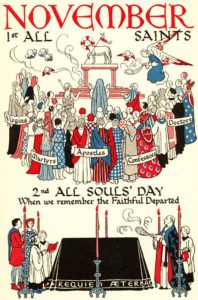On Thursday, November 1, All Saints Day, there will be a 7 a.m. Low Mass and 7 p.m. Solemn High Mass.
On Friday, November 2, All Souls Day there will be a 7 a.m. Low Mass, a 5:30 p.m. Low Mass, and a 7 p.m. Sung Mass with Ablution (no First Friday Adoration). Each Mass has different readings and prayers.
The Ablution, or Libera, ceremony is performed following the Mass. This ceremony takes place at the coffin or, if the body (or bodies) is (are) not present, at a catafalque (a coffin-like structure) or at a black pall spread on the floor. The catafalque or pall represent the body (bodies) of the deceased. During the ceremony, the coffin, catafalque or pall is incensed and sprinkled with Holy Water and prayers are said on behalf of the departed.
In many of the prayers and chants of a Requiem (and thus also the Masses of All Souls’ Day which follow the Requiem rite) and during the Ablution, the first person (I, me) is used. In these places it should be understood that the reciters are speaking for the deceased at the moment of death.
Additionally, it must be kept in mind, that the Liturgy for the dead places the Church and the faithful as pleading figures accompanying the departed soul into the presence of its Judge at the moment of death and praying on its behalf, as it were, before eternal sentence is pronounced. This explains why this Liturgy asks for things which would have chronologically already been decided irrevocably (such as damnation to hell). It should be remembered that “to God, Who sees all times at one glance, this day’s supplication was present at the moment of the dread passage, and obtained assistance for the straitened souls.” (Prosper Guéranger, The Liturgical Year, vol. 15 [Time After Pentecost Book VI], trans. Laurence Shepherd, [Loreto Publications, 2000], 142 [All Souls’ Day]. See also the Old Catholic Encyclopedia, s.v. “Libera Me.” And “Prayers for the Dead.”)


